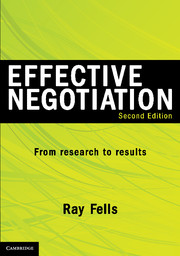Book contents
- Frontmatter
- Contents
- Preface
- Acknowledgements
- 1 Why isn't negotiation straightforward?
- 2 The DNA of negotiation
- 3 The knight's move
- 4 Phases and phrases
- 5 A negotiation script and other ways to manage a negotiation
- 6 Digging deep to deal with differences
- 7 Light bulb moments: exploring for options
- 8 A final balancing act: the end-game exchange
- 9 Building bridges
- 10 Cross-cultural negotiations: much the same but different
- 11 Becoming an effective negotiator
- References
- Index
1 - Why isn't negotiation straightforward?
- Frontmatter
- Contents
- Preface
- Acknowledgements
- 1 Why isn't negotiation straightforward?
- 2 The DNA of negotiation
- 3 The knight's move
- 4 Phases and phrases
- 5 A negotiation script and other ways to manage a negotiation
- 6 Digging deep to deal with differences
- 7 Light bulb moments: exploring for options
- 8 A final balancing act: the end-game exchange
- 9 Building bridges
- 10 Cross-cultural negotiations: much the same but different
- 11 Becoming an effective negotiator
- References
- Index
Summary
This chapter will
describe the pervasiveness of negotiation, which is why negotiation is so important
offer some up-front advice about how to start becoming an effective negotiator
provide a definition of negotiation and demonstrate some practical implications for negotiators
introduce the notion of the DNA of negotiation.
We negotiate a great deal – more than we realise. Sometimes it goes smoothly, sometimes it seems difficult. While there is much advice around about how to negotiate and be a winning negotiator, the actual experience does not seem as straightforward as books suggest. Why? Because negotiation is a complex process. This book grapples with these complexities while recognising the idiosyncrasies of the negotiation process and of the negotiator.
This opening chapter explores some core complexities of negotiation and provides a foundation for later chapters. Although this book will focus on the business context, the principles and skills can be applied in other contexts, such as interpersonal negotiation, sales or when resolving legal, environmental and social issues. Very few people are employed solely as professional negotiators; for most of us it is just an integral, perhaps unrecognised, part of our job.
- Type
- Chapter
- Information
- Effective NegotiationFrom Research to Results, pp. 1 - 10Publisher: Cambridge University PressPrint publication year: 2012



